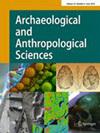Exploring circulation dynamics in Han Dynasty China: insights from isotopic analysis of lead glazed pottery
Abstract
This study investigates lead provenance and circulation patterns in Han Dynasty (202BC-220AD) China through the analysis of lead glazed pottery. Four objects were studied using a combination of typological study, elemental chemistry and lead isotope ratio analysis. The results for each object were compared with databases of ‘lead mining districts’ (lead deposits) and ‘lead usage districts’ (lead-containing artifacts unearthed in different spatial and temporal ranges) to assess the lead sources used for each sample and offers a spatial-temporal range of the use of these lead resources. Three distinct groups of lead and their possible circulating spatial-temporal scales are identified across six samples in this study. A possible change in lead supply networks between the Western Han Dynasty (202BC-9AD) and the Eastern Han Dynasty (25AD-220AD) is proposed. This study also highlights the probable changes in the movement of lead resources from the Western Han Dynasty to the Tang Dynasty (618AD-690AD), suggesting improvements in long-distance transport capabilities, and the development of economic divisions and exchange connections in ancient Chinese society. Our findings contribute to a deeper understanding of the economic and political dynamics during the Han Dynasty and emphasize the significance of lead isotope analysis of glazed pottery in exploring resource movement.

 求助内容:
求助内容: 应助结果提醒方式:
应助结果提醒方式:


